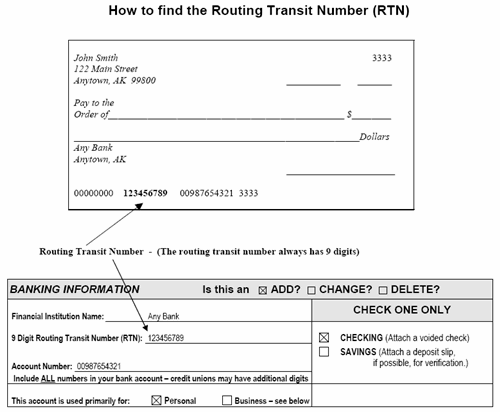Accounting
Electronic Payments (EFT)
Frequently Asked Questions (FAQs)
Click on the questions below to see their corresponding answers or show all answers.
01. What is EFT?
Electronic Funds Transfer (EFT) is the electronic transfer of money from one bank account to another, either within a single financial institution or across multiple institutions, through computer-based systems and without the direct intervention of bank staff.
02. What is FEDI?
Financial Electronic Data Interchange (FEDI) is the electronic exchange of payment instructions and remittance information using a standard format facilitated by financial institutions.
03. What is ACH?
The Automated Clearing House (ACH) is a funds transfer system governed by NACHA rules, which provides for the interbank clearing of electronic entries for financial institutions.
04. What is NACHA?
The National Automated Clearing House Association (NACHA) develops and sets standards for specific types of electronic fund transfers.
05. What are the benefits of electronic payments?
- Increased security and reduction of errors – no more lost/stolen checks
- Increased cash flow for vendors
- Increased timing and certainty of payment
- Vendors have immediate use of funds (financial institutions do not place a hold on electronically transferred funds)
- Controls the timing of payments (no mail float and check clearance)
06. How reliable and safe are electronic payments?
The following are now non-issues when receiving your payments electronically:
- Forged checks
- Lost-in-transit checks
- Stolen checks
07. How does the electronic payment (EFT) process work?
Initial Setup:
The vendor completes the Electronic Payment Agreement form, a signed document authorizing the State of Alaska to make electronic payments directly to the vendor's bank account. It includes information required for the payment process, such as a bank account number, addenda format information (i.e., remittance advice), contact names, phone numbers, etc. It also authorizes theState of Alaska to initiate debit entries and adjustments for any credit entries made in error to the vendor's account.
The vendor submits the completed agreement to the Department of Administration, Division of Finance, for verification and processing. Once the form is processed the Division of Finance sends a prenote, a zero dollar test transaction to verify the accuracy of bank account information before “live” payments are sent. This test usually takes five business days. During this period, state agencies will not be able to send payments to the account electronically. Once the prenote test has ended, state agencies may process electronic payments in the State's Financial System. Payments are processed daily with the exception of holidays, weekends, and special system processing periods.
Transmitting Payment:
Electronic payments are transmitted to the state's banking institution daily, excluding weekends and holidays.
The state's banking institution receives the electronic payment information for the state, they convert the information to ACH entries. These entries are then transmitted electronically to an ACH operator, a central clearing facility for ACH entries. The ACH operator processes the entries received from the state's banking institution and transmits them to the vendor's financial institution.
Receiving Payment:
Upon receipt of the ACH entries, the vendor's bank posts payment information to the vendor's account. Any addenda information (i.e., remittance advice) associated with the payment is provided to the vendor in the format previously agreed upon by the vendor and the vendor's bank. Vendors may also need to work with their banks to satisfy any requirements their banks may have and make arrangements to receive remittance (addenda) information.
Payment is deposited in the vendor's account on the first business day, excluding weekends and holidays, following transmission by the state. This is two business days after the payment is processed in the state accounting system. For example, if the payment is processed on Monday, the payment is transmitted on Tuesday, and then deposited on Wednesday. If the state processed a payment on Friday, and Monday is a holiday, the payment is transmitted on Tuesday, and then deposited on Wednesday.
08. When are electronic payments not processed, transmitted, and deposited?
Payments are not processed on holidays, weekends, and during special processing periods. Transmission and deposits do not occur on holidays and weekends.
Holidays:
Payments processed the business day preceding a holiday are transmitted the first business day following the holiday and are deposited the first business day after transmittal. The State of Alaska observes most standard holidays. For a calendar of state holidays, please refer to our standard State Calendar.
Columbus Day, the second Monday in October, is observed as a holiday by the Federal Reserve, but not by other banking institutions or the State of Alaska. Electronic payments originally scheduled for deposit on Columbus Day (Monday) will deposit on the first business day following the holiday (Tuesday).
Weekends:
Transmission of electronic payments and deposit of funds does not occur on weekends. Electronic payment transactions processed on Friday are transmitted the first business day following the weekend and are deposited on the first business day after transmittal.
09. What do I need to do to receive electronic payments?
Fill out the Electronic Payment Agreement form applicable for your type of payments, attach a voided check or savings deposit slip, and mail or fax the form to us.
Information about the deposits you receive will appear on your bank statement. If this information is not sufficient for you to identify the payments, contact the ACH section of your bank to make arrangements to receive complete remittance information.
10. When will I start receiving my payments electronically?
Upon receiving the completed form, the State of Alaska sends a prenote, a zero dollar test transaction to verify the accuracy of bank account information before “live” payments are sent. This test usually takes five business days. Depending on your bank, you may or may not be notified that this test was processed. After this test has been completed, your payments will be received electronically.
11. What if my bank account information changes?
If your bank account information changes and you want your electronic payments to be deposited to the new account, fill out a new Electronic Payment Agreement form, select “Change” in the Banking Information section, and mail or fax the form to us.
You may mail the Electronic Payment Agreement form to:
State of Alaska
Department of Administration
Division of Finance
PO Box 110204
Juneau, AK 99811-0204
You may fax the form to the State of Alaska at (907) 465-2169.
12. How do I stop receiving electronic payments?
If you wish to stop receiving payments electronically from the State of Alaska, please fax or mail us a memo with signature or send an email requesting to stop receiving electronic payments.
13. Where and how do I send the Electronic Payment Agreement Form?
You may mail the Electronic Payment Agreement form to:
State of Alaska
Department of Administration
Division of Finance
PO Box 110204
Juneau, AK 99811-0204
You may fax the form to the State of Alaska at (907) 465-2169.
14. What if I receive an electronic payment in error?
If you have received a payment in error please email us. Please provide the amount of the payment, the deposit date, and if possible, the EF number (EFT Document ID number) or the check/warrant number.
15. How do I find details for a payment I received electronically?
The State of Alaska (SOA) offers inquiry systems for payments that are made electronically. SOA implemented a new financial system, IRIS, in 2015 and as part of that implementation a new Vendor Self-Service (VSS) application is now available. Among the features offered in VSS, vendors may review payment details. VSS is only accessible from outside the SOA network.
16. Where do I find the ABA Number/Routing Transit Number (RTN) that is required to complete the Electronic Payment Agreement form?
For a checking account, you can find this number on the bottom left of your check as a 9-digit number directly to the left of your account number (see illustration below). This number does not appear on a savings deposit slip. If you would like your payments deposited into your savings account, call your bank to obtain the ABA/RTN.

